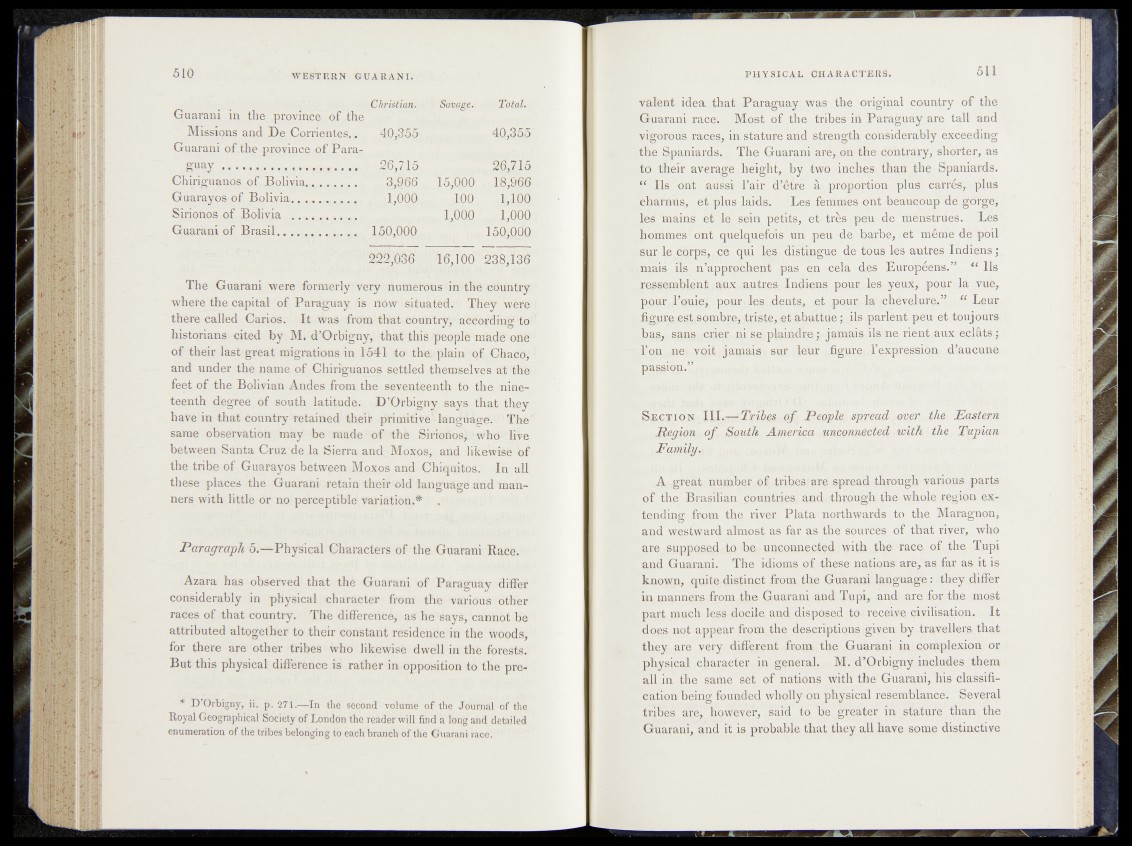
5 1 0 WESTERN GUARANI.
Guarani in the province of the
Christian. 4 7 To tat.
Missions and. De Gorrientes. *
Guarani ofthe province^of Para40,355
1, 4 0 , 3 %
guay ----- / 26,715 2 .6 ,7 j 5
Ghiriguanos of. Bolivia, „ »......... , 3 , 9 , 6 % i j h W u i.8 ,0 ,6 6
Guarayos of Bolivia.. . . . ..4 . . . . . y i , o q p „ 1 0Q , i h W
Sirionos of Bolivia ........... 4. „ 1,0Q0. 1.Q0Û
Guarani óf Brasil.. . . . . . . . . . . 1 5 0 , 6 0 0 ^ .1 5 Q % Q
H I M ]2 % , Ï 3 6 f
The Guarani were formerly‘Very numerous in the country
where the capital of Paraguay is rtéW'Situht&d. Thè’y* W.feŸë"
"there called Carios. It was from that-
historians eitèd by M. d’Orbigny,that“this esté1
of-their last great migrations in 1541 to the; filaib^dfLGfiae#,*
and under the name of Chiriguanos settled themselves^ dt th h
feet of the Bolivian Andes from the seventeenth to the nicfe^
teenth degree of south latitude. D’Orbigny says that they
have in that country retained their primitive^lah^llgd' !Thèf
same observation may be made^èfihë Biriohos)is who ', fiW
between Santa Cruz de la Sierra and Moxos, and likéWrsëbf
the tribe of Guarayos between Moxos and Chiquitos. In all
these places the Guarani retaintheiriold language and manners
with little or no perceptible variation.* .
Paragraph 5.—Physical Characters of the Guarani Race.
Azara has observed that the Guarani of Paraguay differ
considerably in physical character from the various Other
races of that country. The difference, as he says, cannot be
attributed altogether to their constant residence in the woods,
for there are other tribes who likewise dwell in the forests.
But this physical difference is rather in opposition to the pre*
D’Orbigny, ii. p . 271.—-In the second volume of the Journal of the
Royal Geographical Society of London the reader will find a long and detailed
enumeration of the tribes belonging to each branch of the Guarani race.
PHYSICAL CHARACTERS. 511
valent idea~that Paraguay was the original country of the
Guarani jçace. Most of the tribes in Paraguay are tall and
vigorous races, in stature and strength considerably exceeding
,the Spaniards. The Guarani ai’èj on the contrary, shorter, as
to their average .height, by two'-inches, than the Spaniards.
“ Ils? opt au'Ssi l’a ir1 d’e^resia- proportion plus carrés, plus
chhrnUs, > et'plus laids. Les femmes ont béauco'up de gorge,
dés' 'mâins étu&,seip petits; \et-'très »peu de menstrues. Les
ijiommes ont quelquefois ' ùn peu de barbe,, èt même de poil
sur le corps, çë qui lég'fôjj^pgue de tousles autres Indiens ;
limais.' ils n’approchent pas eh -Gela des Européens.” “ Ils
fessjenfolpnt wpx,j Indiens .pour les^yeux, pour la vue,
ppur lfouicT pournlgS dent§i ;e,t ppur-la chevelure.” } “ Leur
figure est sombre, triste, et abattue r il® pjarle^iif^i' et toujours
b§^, i sans cjçier ;.pi se;pMft{|^^ jamais ils/ne, rient aux
-l’qçi.^ô'j vqit jamais sur leur figure Tex-pressions d’aucunè
p^^iop.Ffvj
Section III.— ; çf) ifWKt the Mastern.
of., S.outh America , %negnnectedit, yoith the, Tupian
* Family«.
A grout. number of tribesj are spread through vaEionS: parts
of the Brasihan coupteiegihh^^ltbrough'the whole, region extending
from the river Plata northwards to the Maragnon,
and westward almost as far as the sources of that river, who
are supposed ,to b e , unconnected with the race; ofothe Tupi
and Guarani. The idioms of . these nations are, as far as it is
known, quite distinct from the Guarani language:. they differ
in manners from the Guarani and Tupi,. and are for the most
pa^rt pouch less docile and disposed to receive civilisation. It
does not appear from the dc&CriptiQUS given by travellers that
they are very different fromthuv,Guarani in complexion or
physical character in general. M. d’Orbigny includes them
all in the same set of nations with the Guarani, his classification
being founded wholly on physical resemblance. Several
tribes are, however, said to be ’greater in stature than the
Guarani, and it is probable that they all have some distinctive